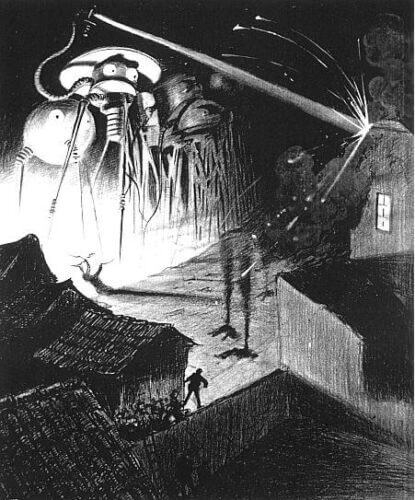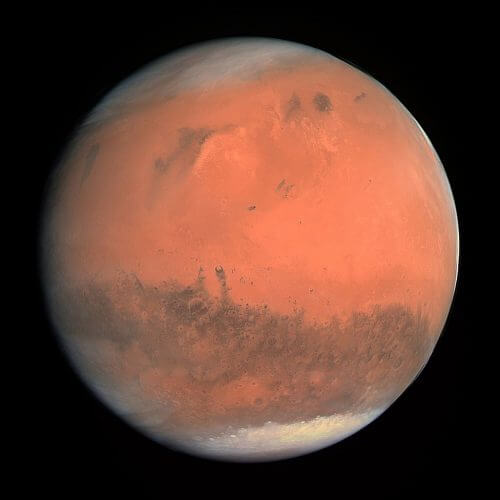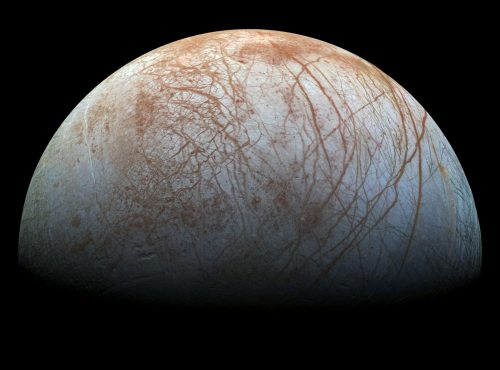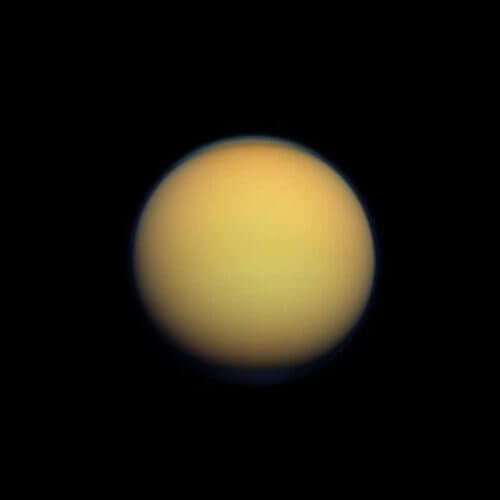The recent discovery of possible biogenic phosphine in the clouds of Venus reminds us that at least some of these elements also exist elsewhere in the solar system. So where are the most promising places for extraterrestrial life?

The Earth's biosphere contains all the known elements necessary for life as we know it. In general, the ingredients are: liquid water, at least one energy source, and some biologically useful elements and molecules.
But the recent discovery of possible biogenic phosphine in the clouds of Venus reminds us that at least some of these elements exist elsewhere in the solar system. So where are the most promising places for extraterrestrial life?
Mars
Mars is one of the most earth-like worlds in the solar system. It has a 24.5-hour day, polar ice caps that expand and contract with the seasons, and a large set of landforms sculpted by water throughout the planet's history.

Mars has ice caps at the poles.
The discovery of a lake under the ice cap of the South Pole and methane in the Martian atmosphere (which changes with the seasons and even the time of day) makes Mars a very interesting candidate for discovering life. Methane is important because it can be produced by biological processes. But it is still unknown what the true origin of methane is on Mars.
Life may have gained a foothold, given the evidence that the planet's environment was once much less dangerous. Today, Mars has a very thin and dry atmosphere that consists almost entirely of carbon dioxide. It allows little protection from solar and cosmic radiation. If Mars has managed to preserve reserves of water below the surface, it is not impossible that life still exists.
EUROPE
Europa was discovered by Galileo Galilei in 1610, along with the three other large moons of Jupiter. It is slightly smaller than Earth's moon and orbits the gas giant at a distance of about 670,000 km every 3.5 days. Europa is constantly compressed and stretched by the competing gravitational fields of Jupiter and the other Galilean moons, a process called tidal stretching.
The Moon is considered a geologically active world, like Earth, because the strong tidal pull heats its rocky, metallic interior and keeps it in a partially molten state.

The ice over Europa is a good sign for alien hunters.
The surface of Europa is a vast area of water ice. Many scientists think that beneath the frozen surface there is a layer of liquid water - a global ocean - that the heat from the traction prevents it from freezing and that is perhaps more than a hundred kilometers deep.
The evidence for this ocean is geysers erupting through cracks in the surface ice, a weak magnetic field, and a chaotic surface, possibly warped by ocean currents swirling beneath. This ice shield insulates the subsurface ocean from the intense cold and emptiness of space, and also from Jupiter's powerful radiation belts.
At the bottom of this ocean world it is conceivable that we might find hydrothermal vents and ocean floor volcanoes. On Earth, such landforms often support very rich and diverse ecosystems.
Enceladus
Like Europa, Enceladus is an ice-covered moon with a subsurface ocean of liquid water. Enceladus orbits Saturn and first caught the attention of scientists as a potentially habitable world after the surprising discovery of giant geysers near the moon's south pole.
These jets of water come out of large cracks in the surface of the ground, and due to the weak gravitational field of Enceladus splash into space. They are clear evidence of an underground reservoir of liquid water.
Not only water was discovered in these geysers but also a group of organic molecules, and most importantly, tiny grains of rock silicate particles whose presence is only possible if the subsurface ocean water was in physical contact with the rocky ocean floor at a temperature of at least 90 C. This is very strong proof of the existence of hydrothermal vents on the ocean floor, which provide the chemistry needed for life and local energy sources.
Titan
Titan is the largest moon of Saturn and the only moon in the solar system with a significant atmosphere. It contains a thick orange haze of complex organic molecules and a weather system of methane instead of water—with seasonal rains, dry spells, and sand dunes on the ground created by the wind.

The atmosphere consists mainly of nitrogen, an important chemical element that is used in the construction of proteins in all known life forms. Radar observations revealed the presence of rivers and lakes of liquid methane and ethane and possibly the presence of ice volcanoes—a volcano-like landform that spews liquid water instead of lava. This suggests that, like Europa and Enceladus, Titan has an underground reservoir of liquid water.
At such a great distance from the Sun, the temperature on Titan's surface is a frigid -180˚C, far too cold to allow for liquid water. However, the abundance of chemicals found on Titan has raised speculation that life forms—perhaps with a fundamentally different chemistry from Earth's organisms—could exist there.

7 תגובות
Where the most promising worlds exist is in………….
in us!
No need to look for oceans outside the earth. Our body is made of the same elements, the same star dust that came from space.
The same atoms that created the water also created our lives in a way that we do not yet have the ability to achieve.
If we were created from those stars, if all our matter came from there, if there is a power planted within us, arranged within us such a form of molecules that will organize us to perceive reality as we perceive it today, with the same five senses and boundaries.
So basically the limits of our perception, the limits of the perception of every creature are based on the limits of its desire, those parts of the essence of its desire, those that make it what it is.
What is the difference between a rock and a plant, between a plant and an animal, between animals? That configuration of molecules that built something very special. And what is this very special something? What can we call him?
If there was a method that would be able to organize in a different way those boundaries of the…..desire? Or let's say to change the organization of the molecules from which we are built, my perception of reality would also change.
To be precise, the earth is a planet and so is Mars and our entire solar system has its own light, the sun is a star, a reactor that converts hydrogen into helium and has its own light, in fact, Mars is considered a potential world for life, you ask why are other planets looking for life? Well... in the future, the earth will not be able to hold us forever and we will have to look for other worlds to settle in and in the meantime, we must take care of the earth and not destroy it because we only have one world for now and if we destroy it, we don't have another.
Phosphine is not necessarily "biogenic" and certainly does not necessarily indicate the existence of "life"! Space explorers captivated by the magic of fictional space movies spread unfounded rumors and the 'social networks' cheer boredom and brain emptiness....
The most suitable planet for existence of life is... Earth!
It is such a shame that we are destroying this amazing planet and on the way we are destroying it
and abuse the variety of life on him.
Eli Isaac
Private computer science teacher
Found at: panda2all.com
to Irina There are no racists either. Tam Lit
Well, that's great, Mars is the planet suitable for human life and it's even better because the corona virus didn't get there and neither did the Chinese
I understood that they discovered phosphine, but why did you decide and write "biogenic"? Although there is phosphine in nature that ignites when it is released into the air, but where does all the phosphine in industry come from? Of course from synthetic phosphine. This is not a very complex reaction. Not much different from ammonia which can indeed come from an organic source but it is not claimed that astronomical ammonia is a sign of life.